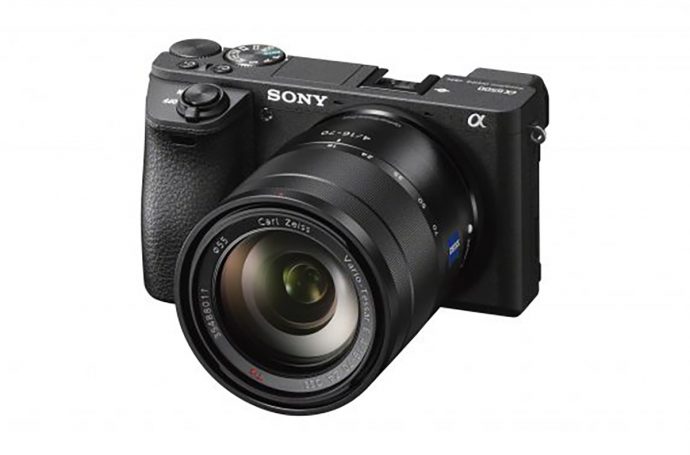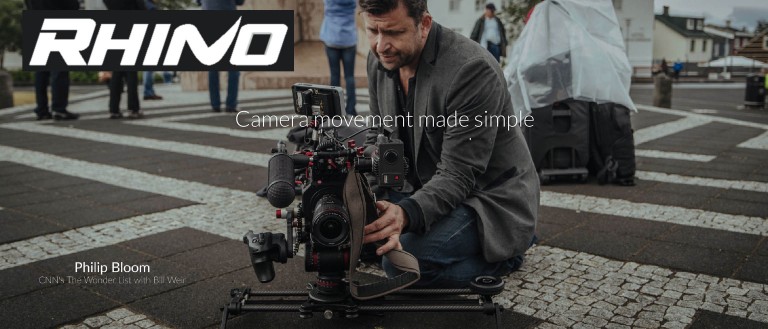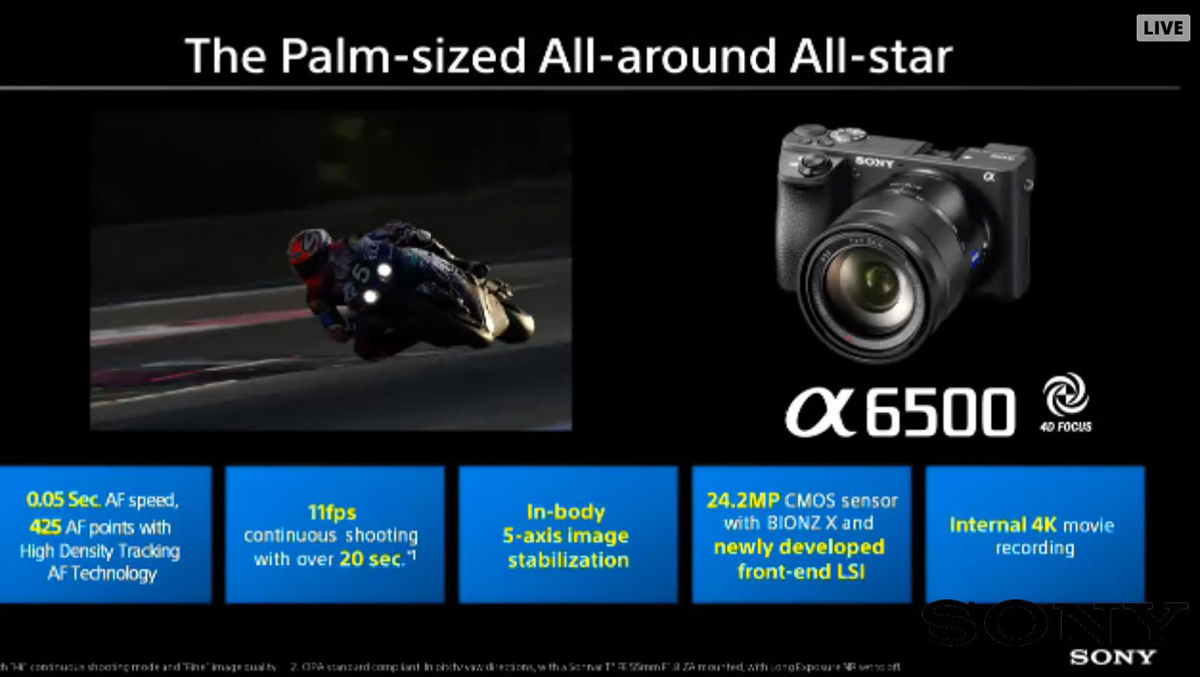
Sony are known for bringing out lots and lots of cameras. It seemed like every week a new camera came out, then on April 16th the Kumamoto Earthquake struck Japan which badly affected Sony’s main sensor factory. They had issues making enough FS5s and FS7s to meet demand because of this. Now almost six months later, they are back on track…
Only a week and a half ago I came back from the HUGE Photokina show in Germany where I was talking on the Sony stage each day about my filming career and my use of Sony cameras over the past few. At the show, their only new camera was the Alpha mount A99 MKII. Whilst this was a beast of a camera, my lack of any Alpha mount lenses and the inability to put Canon or Nikon (and of course E mount glass) made it not that exciting for me.
Well, today they fixed that lack of new Sony camera feeling by announcing two new cameras. A new flagship APS-C camera taking over from the its-only-been-out-for-five-minutes A6300 (which will still exist and continue to be sold), the incrementally monikered A6500, and the replacement for the RX100 IV which is also cleverly named the RX100 V!
What have they done improvement-wise over their predecessors? Quite a lot, really.
Let us start with the Sony A6500.
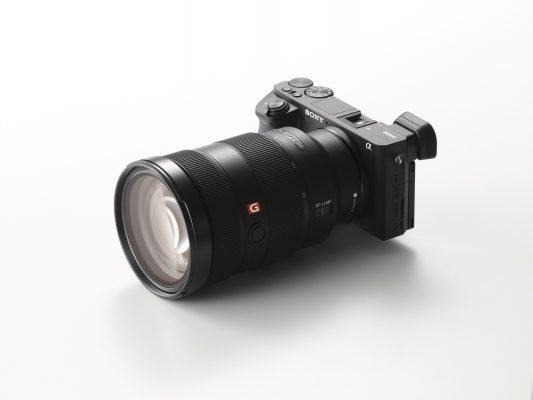
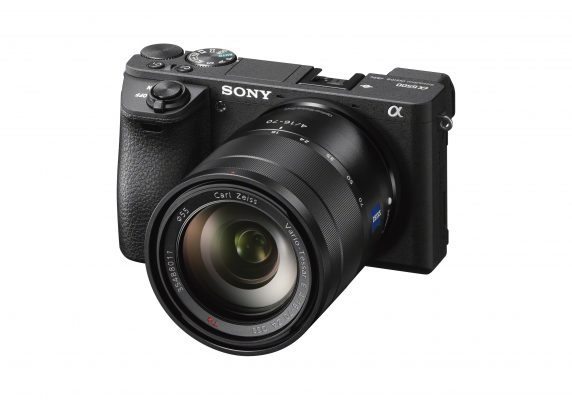
The A6300 is a really nice camera with a fatal flaw (in video mode) that should be improved massively by one of the key features of the A6500. The rolling shutter issues in video made handheld shooting on the A6300 impossible without an OIS lens. In fact, I bought a couple of E mount APS-C lenses with OIS because of this. That didn’t fix the skewing if you panned the camera fast enough or a double-decker bus went through your frame at 30 miles, but it removed the micro jitters and made handheld possible (but only with those lenses!). The super good news is that the A6500 has 5-axis internal stabilisation like the A7 II series of cameras. Whilst this doesn’t fix slow sensor read out that causes rolling shutter issues, it will make handheld shooting possible with any lens, even without OIS. But that isn’t the only good news. Sony have said the camera has a much faster sensor read out in 4K and HD. If this is the case, then this camera could become a must-have for many. I had problems recommending the A6300 because of that rolling shutter issue. I will need to test the A6500 myself to see, but let’s be positive here!
As I write this, I really should be trying to finish my mega-vlog video autofocus edit. It has become a bit of monster, but I am getting there. The A6300 competes against the Canon 1DX MKII (amazing), Sony A7RII (pretty good), A7SII (not so good), Panasonic GH4 (also not so good) and many others. The video autofocus of that camera is really good as it uses phase detection and it also tracks. One of the annoyances for me was that whilst the tracking worked well you couldn’t tell it WHAT to track. The A6500 has a touch screen and touch focus. This will make a HUGE difference (I hope!)
Another new feature is the slow and quick mode that was introduced on the Sony A99 II. In this mode, frame rates from 1 fps to 100fps can be selected in 8 steps for up to 50x quick motion and 4x slow motion recording. This will be proper over-crank, so once it is shot it will be slow motion without any need to conform in post. I don’t know what the bitrate for this mode is, though.
All in all, this looks like a massive improvement over the A6300. I only bought my A6300 in March, so it isn’t exactly old, but these improvements are essential. I would rather they bring out a camera quickly that fixes all the issues than hold off because it hasn’t been out that long. If anyone is interested in buying mine, I am selling it for $1,399 ?
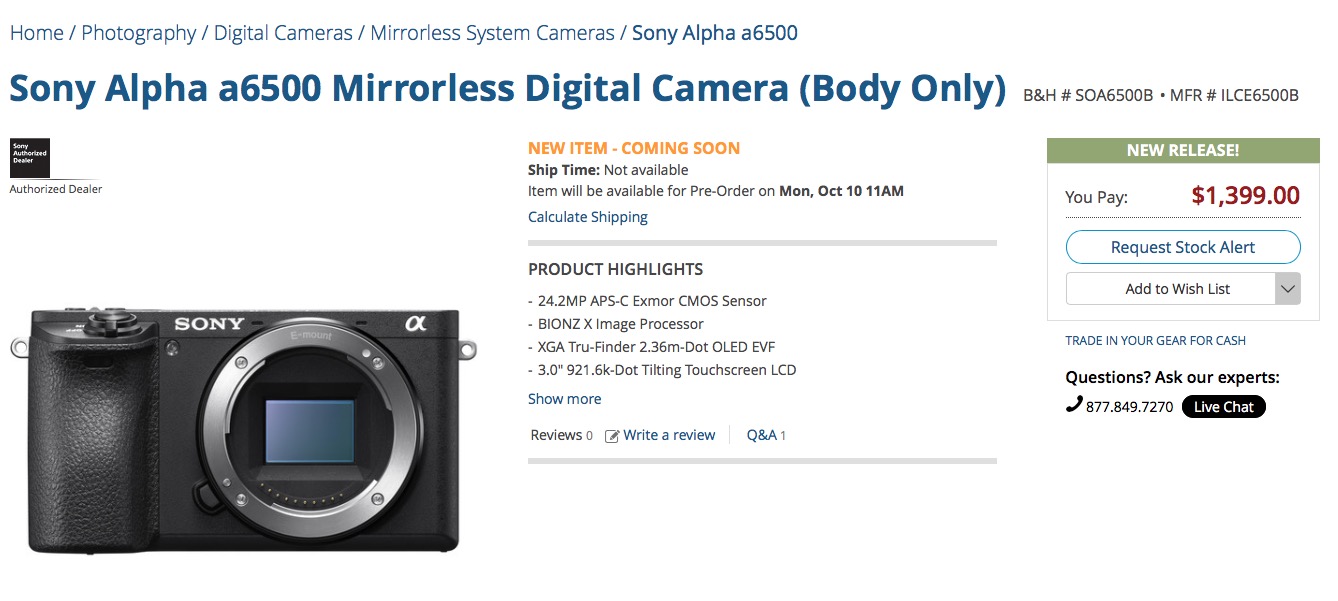
Next up is the RX100 V
I have had all of the RX100 cameras except the III. They have been exceptional little cameras, but the RX100 IV was an incredible update for video. It gave us internal 4K with S-LOG 2 in XAVC-S. 100p/120p full HD and high frame rate in short bursts of 250/240fps (very usable) to the less usable 500/48fps and the unusable 1000/980fps. It also gave us a terrific EVF. The 4K was really nice but was limited to 5 minutes due to heat issues. I cannot see any info about the record time of the RX100 V. What it does improve on, though, are a number of things:
The high frame rate buffer doubles, so you will get 4 seconds at 250/240fps (PAL/ NTSC) which is actually quite a lot. If you look at the below two videos (Call the cleaner shot with a standard RX100 IV and Las Vegas in Infrared with a hardware modded version), they were both shot in this 2-second buffer mode. Having 4 seconds is going to be great. There is a mode to sacrifice vertical resolution to double that again, but I didn’t use it on the IV as the image suffered too much. It remains to be seen if there is a difference here. The camera does have a new sensor though, 20.1mp, so we shall see!
One of its headline features is that, in stills mode, it can shoot 24fps in raw for up to 150 shots. This is amazing!
The other key feature is that phase detection autofocus comes to the RX100 series. The previous models were all contrast based, and the auto-focus was average in stills and rubbish in video. Whilst it doesn’t have the touch screen of the A6500, this is still very good news. Here are some rather mediocre videos to watch! Well, the autofocus one is interesting! They just need to ditch the Casio keyboard scoring! ?
Sadly, they still don’t have a mic input on the camera. For me this is a criminal omission – I really love my RX100 IV, and it would be a brilliant vlogging camera IF it had a mic input. With the flash taking up the spot where the MI shoe would be (which would let you use their XLR add-on or radio mic), you are stuck with the average quality internal mic.
These improvements, especially the autofocus, make this camera seem very appealing. The RX100 IV is easily the best compact camera on the market, this should take that crown.
I hope to test both new cameras soon!
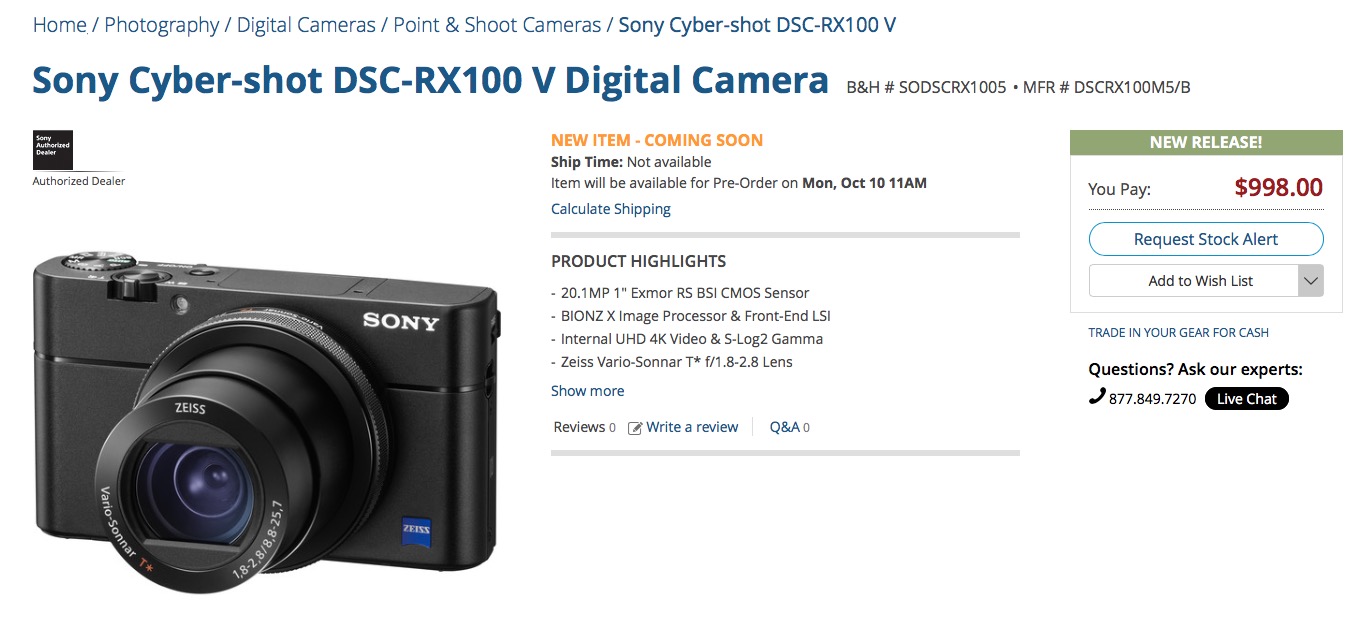
Full Press Release for Sony RX100 V
New Compact RX100 V Model Boasts World’s Fastest AF Speed[i], World’s Most AF Points and World’s Fastest Continuous Shootingi for a Compact Camerai
Sony today announced a new flagship model for their popular Cyber-shot RX100 series of compact cameras, the RX100 V (model DSC-RX100M5).
The exciting new camera brings a new level of AF performance and speed to today’s compact camera market. It is equipped with a Fast Hybrid AF system with the world’s fastest AF acquisitioni at 0.05 seconds[ii] and world’s highest number of AF points on sensori with 315 points covering approximately 65% of the frame. The camera can also shoot continuously at speeds of up to 24 fps[iii] – the world’s fastest for a compact camerai – at full 20.1 MP (approx. effective) resolution with AF/AE tracking for up to 150 continuous shots[iv].
The RX100 V is equipped with a newly developed 1.0-type stacked Exmor RS™ CMOS sensor with a DRAM chip, a ZEISS® Vario-Sonnar T* 24-70 mm[v] F1.8 – 2.8 large aperture lens and an enhanced image processing system with a new front-end LSI chip that maximises processing speed, expands the memory buffer and optimises image quality, in particular at high ISO settings. The camera also features 4K video recording with full pixel readout and no pixel binning[vi], super slow motion recording at up to 1000 fps[vii] with extended recording time and more.
Fast Focusing, Fast Shooting
A first for Sony’s RX100 series of cameras, the new RX100 V model features a Fast Hybrid AF system that combines the respective advantages of focal-plane phase detection AF and contrast detection AF and ultimately enables the camera to lock focus in as little as 0.05 seconds.ii This high speed focusing is a perfect complement to the 315 dedicated AF points that cover 65% of the sensor, and ensures that shooters will be able to capture their intended subject with high speed and accuracy, even if it’s moving rapidly in unpredictable directions.
Additionally, processing speed has been greatly enhanced through the addition of a front-end LSI that perfectly supports the camera’s BIONZ X™ image processing engine. These two components combined with the powerful AF system allow the camera to shoot continuously at speeds of up to 24 fpsiii at full 20.1 MP (approx. effective) resolution for up to 150 shotsiv with AF/AE tracking. Viewfinder blackout between shots has also been minimised in this high-speed shooting mode, which greatly improves photographers’ ability to follow fast action and capture the decisive moment. Silent shooting is also available in these high-speed modes as well.vii
Other advancements to AF performance on the new RX100 V include the addition of AF-A mode, which allows the camera to automatically switch between continuous and single-shot AF modes. Users can also manually select if they’d like the continuous AF and phase detection AF areas to be displayed live on screen while they are framing a shot.
The RX100 V also has a high speed Anti-Distortion Shutter (maximum speed of 1/32000 second) that minimises the “rolling shutter” effect commonly experienced with fast moving subjects. This fast shutter speed also allows the camera to capture sharp, crystal clear images with a wide open aperture at brightness levels up to EV19.[viii] Shooting at wide aperture with the fast shutter speed allows photographers and videographers to capture beautiful content with sharply focused subjects and defocused backgrounds under some of the most difficult, bright lighting conditions.
New on the RX100 V, users can freely select the initial magnification ratio when shooting in a mode with Focus Magnifier, and can select between “focus point” and “centre of display” for the location of Focus Magnifier.
Professional Movie Functionality
The pocket-friendly RX100 V is packed with a variety of video capabilities that will satisfy even the most demanding video enthusiasts.
With Fast Hybrid AF, the focal plane phase detection AF sensor ensures accurate focusing and tracking performance, even for the severe focusing requirements of 4K movie shooting. AF drive speed and AF tracking sensitivity can also be adjusted via the menu system, giving shooters plenty of flexibility based on their focusing preferences.
In 4K mode,vi the new RX100 V utilises full pixel readout without pixel binning to ensure that all the finer details of 4K video are captured with minimal moire and ‘jaggies’. These high-quality results are achieved through use of the XAVC S codec, which records video at a high data rate of up to 100 Mbps during 4K recording and 50 Mbps during full HD shooting[ix].
Additional professional grade video features include Picture Profile, S-Log2 /S-Gamut, 100p HD Full HD mode and more. Users also have the ability to manually select a frame from a recorded movie and save it as a still image file of approximately 8 MP during 4K shooting or 2 MP during HD shooting.
The RX100 V is able to record super-slow motion video[x] at up to 40x slower than the standard rate, and can do this for about twice as long as the RX100 IV model. This extended time allowing users to capture a series of high-speed, fleeting moments of action with incredible detail, resolution and clarity.
Prior to shooting, users will have the ability to choose among 1000fps, 500fps and 250fps frame rates and among 50p and 25p playback formats to optimise the recording to fit the speed of the moving subject, with the option to use the movie record button as a ‘start trigger’ to begin recording once button is pressed or ‘end trigger’ to record footage up until the button is pressed.
Pocket-Friendly Design, Premium Performance
The new RX100 V maintains the convenient pocket-sized design of the remainder of the RX100 family and is equipped with a high-contrast 2.35 million dot XGA OLED Tru-Finder™, ensuring true-to-life image preview and playback functionality. The EVF conveniently retracts in and out of the camera body based on user preference, and features optics with ZEISS® T* Coating.
The new camera is also Wi-Fi® and NFC™ compatible and can access Sony’s growing range of PlayMemories Camera Applications. Learn more at www.sony.net/pmca.
Another convenient addition is the ability for users to freely set the leading three characters of saved file names for easier sorting and organisation.
There will also be a new underwater housing (model MPK-URX100A) that will be available as a separate accessory for the RX100 V and all other RX100 series cameras. Designed exclusively to fit the RX100 cameras, the housing features a depth level of 40m/130ft.
Pricing and Availability
The new Sony Cyber-shot RX100 V (model DSC-RX100M5) compact camera will be available in Europe in November priced at approximately €1,200. The MPK-URX100A underwater housing will be available for approximately €360.
[i]Among fixed lens digital cameras with 1.0-type sensor. As of October 2016 press release, based on Sony research.
[ii] CIPA standard, internal measurement, at f=8.8mm(wide telephoto), EV4.7, Program Auto, Focus mode: AF-A, AF area: Wide
[iii] With “Continuous shooting mode: Hi”.
[iv] With “Continuous shooting mode: Hi” and “Image quality: Fine”.
[v]35mm equivalent
[vi] Continuous recording is available for approx. 5 minutes. The duration available for the shooting may change according to shooting conditions.
[vii] Silent shooting can be activated via “Shutter type: Electronic” and “Audio signals: Off”.
[viii]Using built-in ND filter.
[ix] An SDHC/SDXC memory card with a Class 10 or higher speed rating is required for XAVC S recording and UHS Speed Class 3 is required for recording at 100Mbps
[x]Sound cannot be recorded when shooting slow motion. An SDHC/SDXC memory card of Class 10 or higher is required.
Sony Corporation is a leading manufacturer of audio, video, imaging, game, communications, key device and information technology products for the consumer and professional markets. With its music, pictures, computer entertainment and online businesses, Sony is uniquely positioned to be the leading electronics and entertainment company in the world. Sony recorded consolidated annual sales of approximately $72 billion for the fiscal year ended March 31, 2016. Sony Global Web Site: http://www.sony.net/
Sony today introduced its new flagship APS-C sensor camera, the α6500 (model ILCE-6500). As the latest addition to Sony’s line-up of award winning mirrorless cameras, the new α6500 shares the same unrivalled 4D FOCUS™ system as the α6300 camera, which can lock focus on a subject in as little as 0.05 seconds, the world’s fastesti AF acquisition time. Also shared with the α6300, the new α6500 features 425 phase detection AF points that are densely positioned over nearly the entire image area – the world’s highestii number of AF points on any interchangeable lens camera. The new model can shoot images at up to 11 frames per second with continuous autofocus and exposure tracking and up to 8 frames per second in a live-view shooting mode that makes it easy to track fast moving subjects, as it combines all of the benefits of an electronic viewfinder with the immediacy of an optical viewfinder.
The camera can shoot at these high speeds for up to 307 frames[iii] thanks to its expanded buffer, which, along with the fast response speeds described above, are all achieved with the support of a new front-end LSI chip that has been added to the camera. This new front-end LSI also serves to enhance both still and video image quality.
Additionally, the new α6500 features Sony’s acclaimed in-camera 5-axis optical image stabilisation, making it the first Sony APS-C sensor camera to offer all of the benefits of advanced in-body stabilisation, which include a shutter speed advantage of approximately 5 steps[iv]. It also offers touchscreen AF capabilities for focus point selection and adjustment.
Unmatched AF Capability
Sony’s new α6500 camera utilises the same 4D FOCUS system as the α6300 – a Fast Hybrid AF system that combines high-speed phase detection AF with extremely accurate contrast AF and allows it to capture and lock on to moving subjects in as little as 0.05 secondsi. It also features 425 phase detection AF points and High-density Tracking AF Technology, which significantly improves subject detection and tracking performance.
New for the α6500, thanks to faster internal processing capabilities enabled by the front-end LSI, the maximum buffer for high-speed continuous shooting is an impressive 307 framesiii, greatly increasing the chances to catch that decisive moment.
The camera’s 425 phase detection AF points, focusing tracking and accuracy are also available when using non-native A-mount lenses[v]with Sony’s LA-EA3 mount adaptor. Additionally, it includes silent shooting, Eye AF in AF-C mode, AF in focus magnifier modes, Expand Flexible Spot AF and more.
5-axis Image Stabilisation Provides 5 Steps Shutter Speed Advantage
One of the most exciting developments in the new α6500 is the implementation of 5-axis image stabilisation for the first time in a Sony APS-C sensor camera. Additionally, through a total revision of the internal design of the camera, this newly developed stabilisation system fits entirely within a body that is nearly the same size as the α6300 model.[vi] This innovative 5- axis system provides a shutter speed advantage of 5 steps,iv ensuring the full resolving power of the sensor can be realised, even in challenging lighting.
The shake compensation provided by the system works with a variety of lenses, including E-mount lenses without OSS (Optical SteadyShot) stabilisation and A-mount lenses[vii] when used with a compatible mount adapter. When an E-mount lens with OSS is mounted, pitch and yaw are compensated in the lens and horizontal, vertical and roll axes are compensated in the camera body, resulting in optimal 5-axis stabilisation.vii
Also, with a simple half press of the shutter button, the effect of the image stabilisation can be monitored in the viewfinder or on the LCD screen, allowing framing and focus to be accurately checked and continually monitored. This is available even when a lens is attached that does not have built-in shake compensation.
New Touch Screen Focusing
The new α6500 comes equipped with touch screen functionality, allowing users to lock focus on a subject simply by touching it on the screen. This is a powerful compliment to its advanced AF system and video shooting capabilities.
Additionally, in a first for Sony cameras, the α6500 features touchpad functionality. When utilising the viewfinder for framing and shooting, the LCD screen can be used as a touch pad. Simply drag a finger across the screen to shift the focus point from one area to another.
Powerful 24.2 MPviii Exmor CMOS Sensor, BIONZ X® Processor and New Front-End LSI
The new α6500 features an APS-C sized 24.2 MP[viii] Exmor CMOS sensor that works together with a BIONZ X image processor and the newly developed front-end LSI to maximise processing power and achieve an impressive sensitivity range of ISO 100-51200.[ix]
The image sensor employs a thin wiring layer and large photodiode substrate that maximises light collection efficiency, plus copper wiring in its structure for outstanding read-out speed. The BIONZ X image processor and newly developed front-end LSI ensure superior image and video quality with low noise even when using higher ISO settings, in particular those at high sensitivity values where other cameras typically struggle. The LSI is also responsible for the expanded buffer depth for continuous shooting.
Professional Video Capabilities
The new α6500 becomes the latest Sony interchangeable lens camera to offer internal 4K movie recording, as it can shoot 4K (3840x2160p) video in the popular Super 35mm format on the full width of the image sensor. When shooting in this format, the camera uses full pixel readout without pixel binning to collect 6K of information – approximately 2.4x[x] (20 MP equivalent) as many pixels as 4K UHD and then oversamples the information to produce high quality 4K footage with exceptional detail and depth.
Additionally, the α6500 will focus exceptionally fast during movie shooting thanks to its Fast Hybrid AF system, offers touch focusing for professionally smooth focus shifts, whilst also offering adjustable AF transition speed and AF tracking sensitivity. The camera supports the XAVC S codec[xi] during video shooting, which records at a high bit rate of up to 100 Mbps during 4K recording and 50 Mbps during Full HD shooting, ensuring maximum detail and clarity in both video formats.
Other professional calibre video features include the ability to record Full HD at 100fps at up to 100 Mbps, which allows footage to be reviewed and eventually edited into 4x slow motion video files in Full HD (25p) resolution with AF tracking.
New on the α6500 is the incorporation of a ‘Slow and Quick’ (S&Q) mode that supports both slow motion and quick motion. In this mode, frame rates from 1 fps to 100fps can be selected in 8 steps for up to 50x quick motion and 4x slow motion recording[xii]. Footage shot in this mode can be previewed after shooting without the need for PC-based post processing.
The camera also offers S-Log gamma recording[xiii] for wide dynamic range shooting – approximately 14-stop latitude in S-Log3 gamma setting – and supports S-Gamut for a wider colour space. Both options allow for greater creativity for processing video post-production.
Shooters also now have the ability to select, extract and save still images from movie footage directly on the camera. Approximately 8 MP images and 2 MP images can be pulled from 4K modes and Full HD modes, respectively.
Enhanced Operability and Reliability
The new α6500 has a refined design, maintaining the mobility of the α6000 series while adapting much of the usability of Sony’s acclaimed α7 II series. The new model features the same high contrast, high-resolution 2.4 million dot XGA OLED Tru-Finder as the α6300 that offers exceptional corner-to-corner visibility.
New hardware features on the α6500 include a magnesium alloy body and a high-durability shutter with a tested life span of approximately 200,000 release cycles.[xiv] It also has several design features that are borrowed from the α7 II series of full-frame cameras, which include a robust lens mount, a recessed grip to improve handling, a larger release button and ten total custom buttons including ‘C1’, ‘C2’ and ‘C3’. It also has an improved operation feel for its mode and control dials and rear face buttons, as well as a softer eyepiece cup for more comfortable usage.
On the software front, there is a new overall user interface, which allows for a much smoother process for searching and adjusting menu settings, as well two new metering modes – Highlight, where exposure metering is focused on the brightest area of the frame, and Entire Screen Avg, which maintains an average metering for the entire image.
The camera is Wi-Fi®, QR and NFC compatible and fully compatible with Sony’s PlayMemories Mobile™ applications[xv] available for Android™ and iOS platforms, as well as Sony’s growing range of PlayMemories Camera Apps™. The α6500 also offers location data acquisition via a Bluetooth[xvi] connection to a compatible mobile device and an updated menu structure to deliver a smoother navigational experience.
Pricing and Availability
The new Sony α6500 interchangeable lens camera will be available in Europe in December priced at approximately €1,700 body only or €2,800 with SEL1670Z lens. Full product details can be seen here. The current α6000 will also see a new colour introduction in Europe in December with the model also available in Graphite Grey.
The new content will also be posted directly at the global Sony Photo Gallery and the Sony Camera Channel on YouTube.
[i]Among interchangeable-lens digital cameras equipped with an APS-C image sensor as of October 2016, based on Sony research, measured using CIPA-compliant guidelines, and internal measurement method with an E PZ 16-50mm F3.5-5.6 OSS lens mounted, Pre-AF off and viewfinder in use.
[ii]Among digital cameras as of October 2016, based on Sony research.
[iii]With “Hi” continuous shooting mode and “Fine” image quality.
[iv]Based on CIPA standard. Pitch/yaw shake only. With Sonnar T* FE 55mm F1.8 ZA lens mounted. Long exposure NR off.
[v]A-mount lenses with SSM or SAM only. Users can choose phase-detection AF or contrast-detection AF in AF System menu. “Phase-detection AF” is not available during movie shooting. AF-C in AF System menu is available only with “Contrast-detection AF” selected, but no motion tracking is performed during continuous shooting (Hi+, Hi, Mid).
[vi]Excluding grip, frontal-view size and main body thickness are the same as for the α6300
[vii]All 5-axis stabilisation is performed in-camera when SEL90M28G is mounted
[viii]Approximate effective MP
[ix]Standard ISO range: 100-25600 for stills and movies. Expandable up to ISO 51200 for stills only.
[x]In 25p recording.
[xi]SDHC/SDXC memory card of Class 10 or higher is required for movie recording in XAVC S format. UHS-I (U3) SDHC/SDXC card is required for 100Mbps recording.
[xii]Sound cannot be recorded. SDHC/SDXC memory card of Class 10 or higher is required.
[xiii]S-Log2 and S-Log3 are premised on processing pictures
[xiv]With the electronic front curtain shutter, under internal test conditions of Sony.
[xv]Use the latest version of PlayMemories Mobile
[xvi]Can be connected via Bluetooth with smartphones featuring (as of the date of release):
- -Android (Android 5.0 or later, Bluetooth 4.0 or later)
- – iPhone/iPad(iPhone 4S or later/iPad 3rd generation or later)
Read more at http://www.amateurphotographer.co.uk/latest/photo-news/sony-unveil-sony-a6500-96587#SGwe1LSZxyBpCPGC.99

